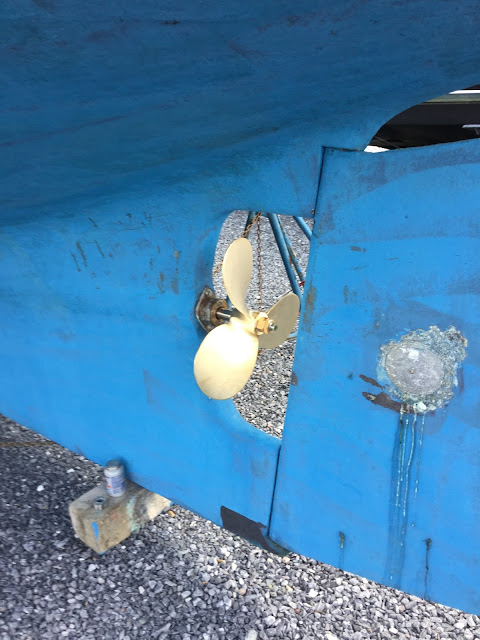Now at Rosalind, Captain Mike handed me a bridle attached to the 2 inch (50 mm) diameter hawser, which would be used to tow us. I ran the bridle lines through the fairleads at the bow and attached them to the bollard. With Cheryl at the helm and me at the bow, he payed out the hawser. We had readied the windlass and started pulling up the anchor chain with the windlass remote. Captain Mike was slowly moving the towboat forward and when Rosalind's anchor chain was almost taut, and without any prompting, he said, "Let me give you a short pull to get your anchor free." With the anchor free, it took but a minute to get the remaining 18 ft (5.5 m) of chain on board. With the anchor on the bow roller, the only thing left to do was to move the bridle over the anchor so that when the towboat pulled us, the anchor would not be forced up on the roller and hit the boat.
With the bridle sorted and the hawser taut, I went aft and took the helm. The towboat headed west and we followed, picking up speed to 6 knots (11 km/h).
Rosalind being pulled along in Herring Bay
In less than fifteen minutes, we passed the Herring Bay Light Red 2 at the south end of Herring Bay. There is a shoal spit from the marker all the way to the northern end of Herring Bay. The depth sounder momentarily registered 5.5 feet (1.7 m) as we rounded the mark. Our depth sounder is to port and with the shoal to starboard, we had less than 6 inches (15 cm) of water under our keel. We informed the Captain and he made a slight course correction. Twenty minutes later, we were slowing down. We were just outside the breakwater at Tracy's Landing. I released the bridle from the bollard, Captain Mike flaked the hawser in the towboat and came alongside Rosalind. We were securing the towboat on Rosalind's aft starboard quarter when a 50 ft (15 m) powerboat came off a plane within a boat length from us. Its wake caused Rosalind and the towboat to bang together violently. Luckily, the fenders did their job and neither boat or our suspended dinghy got damaged. The Captain aptly said, "Some people just think about themselves..." We got Rosalind and the towboat tied together and we started moving forward. I turned the wheel to starboard and the Captain picked up the slack on the forward line holding both boats together. Doing barely 3 knots (5.5 km/h), we passed the breakwater and entered the channel. A 40 ft (12 m) fiberglass sloop was a little over 50 ft (15 m) in front of us. Going over the entrance, the depth sounder registered 5.5 then 5.3 then 5.1 ft (1.7 then 1.6 then 1.55 m). No much to do other than push on. The depth sounder dropped to 4.9 ft (1.5 m). We barely had an inch (2.5 cm) of water under our keel! Then, we were over the sandbar and in deeper water. I called the marina and informed them of our location.
The marina was going to send a dockhand to help us get Rosalind in her slip. I shared the slip location information with Captain Mike and a couple of minutes later we were slowing down and turning to port into the fairway between docks G and H. Cheryl had prepared and positioned our docking lines and Captain Mike eased us into slip H8. Rosalind rested in the middle of the slip, without having touched the dock or any of the pilings. Captain Mike is a true pro! We secured Rosalind in her slip and went to grab a lunch.
Rosalind gently placed in slip
The next day, we went on board and took care of the fuel system. We drained fuel from both tanks and confirmed that there was no more water in either tank. We also made sure no water had entered the engine through the engine exhaust system from the waves slamming our stern when we were at anchor. Everything was fine. We started the engine and let her run for 40 minutes. Rosalind was now ready to be hauled.
Thank you for following along,
Alex and Cheryl




















